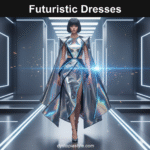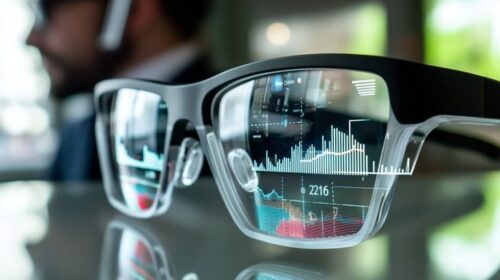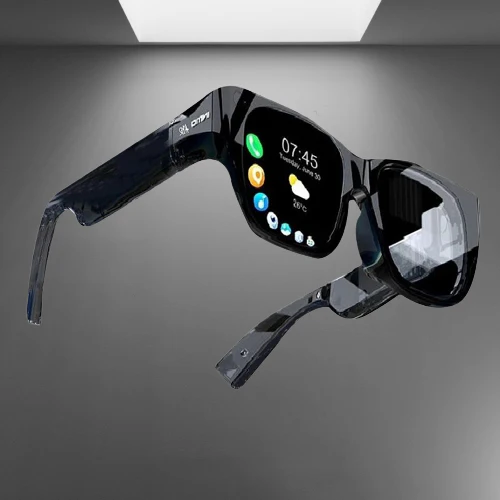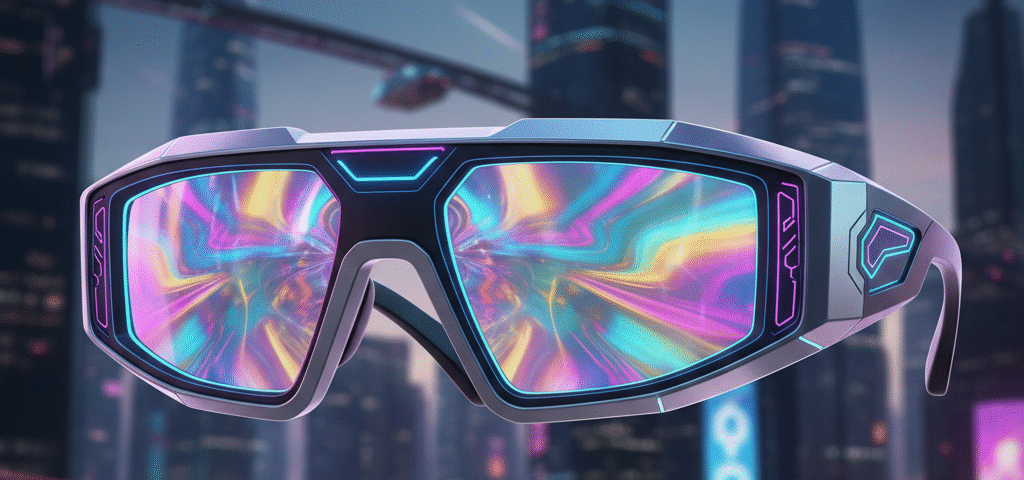
Exploring Futuristic Watches: Innovations and Trends Shaping the Future of Timepieces
October 5, 2025
Futuristic Dresses: Embracing Tomorrow’s Fashion Trends in 2025
October 5, 2025In an era where technology seamlessly blends with everyday fashion, futuristic sunglasses stand out as a game-changer. These aren’t your ordinary shades designed solely for sun protection; they represent the pinnacle of innovation, integrating augmented reality (AR), artificial intelligence (AI), and smart features into stylish eyewear. As we step into 2025, futuristic sunglasses are evolving from niche gadgets to must-have accessories for tech-savvy individuals. Whether you’re navigating city streets with real-time directions overlaid on your view or capturing high-quality videos hands-free, these high-tech glasses offer a glimpse into a connected future.
The appeal of futuristic sunglasses lies in their ability to enhance daily life without compromising on aesthetics. Brands are pushing boundaries, creating designs that look like classic sunglasses but pack powerful tech under the hood. From live translations to health monitoring, the features cater to professionals, travelers, and fitness enthusiasts alike. This article dives deep into the world of futuristic sunglasses, exploring their evolution, key features, top models, benefits, and emerging trends. By the end, you’ll have all the insights needed to choose the perfect pair for your lifestyle.
The Evolution of Sunglasses to Futuristic Designs
Sunglasses have come a long way since their inception in the 12th century as simple tinted lenses for eye protection. By the 20th century, they became fashion statements, popularized by icons like Audrey Hepburn and Tom Cruise. However, the real transformation began in the 2010s with the advent of smart eyewear. Google’s Glass project in 2013 introduced AR overlays, though it faced privacy concerns and bulky design issues.
Fast-forward to 2025, and futuristic sunglasses have addressed those early pitfalls. Advances in micro-OLED displays, lightweight materials, and AI integration have made them sleeker and more functional. Today’s models resemble traditional sunglasses but incorporate cutting-edge tech like dimmable lenses and embedded cameras. This evolution reflects a broader trend in wearable technology, where functionality meets fashion. For instance, the shift from basic UV protection to interactive AR experiences marks a significant leap, driven by consumer demand for multifunctional devices.
As semantic SEO practices emphasize, understanding related terms like “smart eyewear” or “AR glasses” helps contextualize futuristic sunglasses within the larger tech ecosystem. This progression not only enhances user experience but also opens doors to applications in healthcare, education, and entertainment.

Credit: pinterest
Key Features of Futuristic Sunglasses
What sets futuristic sunglasses apart are their innovative features that go beyond mere style. At the core is augmented reality integration, allowing users to see digital information overlaid on the real world. For example, navigation apps can project directions directly onto your field of view, making hands-free exploration a reality.
AI assistants are another hallmark, with built-in voice commands for tasks like live translation or object identification. Models often include high-resolution cameras for capturing photos and videos, some supporting up to 3K resolution with stabilization. Audio features, such as open-ear speakers, enable music playback, calls, and podcasts without isolating you from your surroundings.
Dimmable or electrochromic lenses adjust tint levels with a simple gesture, transitioning from clear indoors to dark outdoors. Battery life has improved dramatically, with some pairs lasting up to 12 hours on a single charge. Health monitoring capabilities, like step counting or UV exposure tracking, add a wellness dimension. Connectivity is seamless via Bluetooth or USB-C, compatible with smartphones, laptops, and even gaming consoles.
For semantic optimization, consider synonyms like “high-tech shades” or “intelligent eyewear,” which highlight the blend of optics and electronics. These features ensure futuristic sunglasses aren’t just accessories but essential tools for modern living.
Top Brands and Models of Futuristic Sunglasses
The market for futuristic sunglasses is booming, with several brands leading the charge. Meta, in collaboration with Ray-Ban and Oakley, offers some of the most popular options. The Ray-Ban Meta Gen 2 stands out with its 12-hour battery, 3K video recording, and AI for live translations and environmental insights. Priced at around $379, it comes in various styles, including polarized lenses for a true sunglass feel.
Oakley Meta HSTN appeals to active users with its rugged design, similar AI features, and enhanced durability. For AR enthusiasts, XReal’s One Pro delivers a wide 57-degree field of view with micro-OLED displays, ideal for virtual screens during travel or work, costing about $600.
Viture Luma Pro, at $499, excels in display quality for gaming and productivity, featuring a 52-degree FOV and comfortable fit. Budget-friendly picks include RayNeo Air 3s ($269) for entertainment-focused AR and Solos AirGo 3 ($249) with ChatGPT integration for voice assistance.
Chamelo Music Shield offers adjustable tint and sweat resistance for fitness, while Nautica Smart Eyewear by Lucyd provides affordable AI access at under $100. These models incorporate semantic elements like “wearable tech” to appeal to a broader audience, ensuring versatility across lifestyles.
Benefits and Applications of Futuristic Sunglasses

Credit: pinterest
Embracing futuristic sunglasses brings numerous benefits. Primarily, they enhance productivity by providing instant access to information without pulling out your phone. For travelers, real-time translations and navigation overlays simplify international trips. In fitness, features like audio coaching and health tracking motivate users during workouts.
Privacy and convenience are key, with hands-free operation reducing distractions. Applications extend to professional fields: surgeons use AR overlays for precision, while educators leverage interactive displays for teaching. Entertainment-wise, watching movies on a virtual giant screen during commutes is transformative.
From a semantic perspective, terms like “augmented eyewear” underscore their role in blending digital and physical worlds, improving accessibility for those with visual impairments through AI descriptions. Overall, these benefits make futuristic sunglasses indispensable for a connected lifestyle.
Future Trends in Futuristic Sunglasses
Looking ahead, futuristic sunglasses are poised for even greater advancements. By 2026, expect fuller AR integration with holographic displays and gesture controls. Brands like Meta and Google are developing neural interfaces for seamless brain-to-device communication.
Sustainability will rise, with eco-friendly materials and longer-lasting batteries. Health features may expand to include biometric scanning for early disease detection. The fusion of VR elements could create mixed-reality experiences, blurring lines between virtual and real.
Semantic SEO trends suggest focusing on “next-gen smart shades” to capture emerging searches. As 5G and AI evolve, futuristic sunglasses will become more intuitive, potentially replacing smartphones in daily tasks.
How to Choose the Right Futuristic Sunglasses
Selecting futuristic sunglasses involves considering your needs: prioritize AR for productivity or AI for assistance. Check battery life, comfort, and compatibility. Budget plays a role—entry-level models start at $200, while premium ones exceed $500. Read reviews for real-world performance and ensure prescription options if needed. Ultimately, try them on for fit, as style remains crucial.
Frequently Asked Questions (FAQs)
What are futuristic sunglasses?
Futuristic sunglasses are smart eyewear combining traditional sunglass designs with tech like AR, AI, and cameras for enhanced functionality.
Are futuristic sunglasses worth the investment?
Yes, if you value hands-free tech for navigation, entertainment, or productivity, they offer significant convenience over regular shades.
Can futuristic sunglasses be used with prescriptions?
Many models, like Ray-Ban Meta, support prescription lenses, making them accessible for those needing vision correction.
How do futuristic sunglasses protect your eyes?
They include UV protection, dimmable lenses, and sometimes blue-light filtering to safeguard against sun and screen exposure.
What is the battery life like on futuristic sunglasses?
It varies; top models like Meta Gen 2 offer up to 12 hours, while others last 2-6 hours depending on usage.
Are there privacy concerns with futuristic sunglasses?
Cameras and mics raise issues, but features like LED indicators signal recording, and data is typically user-controlled.
Where can I buy futuristic sunglasses?
Available on Amazon, brand sites like Meta or XReal, and retailers like Best Buy.
Final Words on Futuristic Sunglasses
As we wrap up our exploration of futuristic sunglasses, it’s clear that these innovative devices are more than just a trend—they’re a transformative force in how we interact with the world. Blending cutting-edge technology with timeless style, futuristic sunglasses empower users to stay connected, informed, and protected in an increasingly digital landscape. Whether you’re drawn to AR overlays for immersive experiences, AI assistants for seamless assistance, or simply the convenience of hands-free functionality, investing in a pair could redefine your daily routine. As technology continues to advance, expect even more exciting developments that make futuristic sunglasses an essential part of our future. If you’re ready to step into tomorrow’s eyewear, start browsing options today and see the world through a smarter lens.



